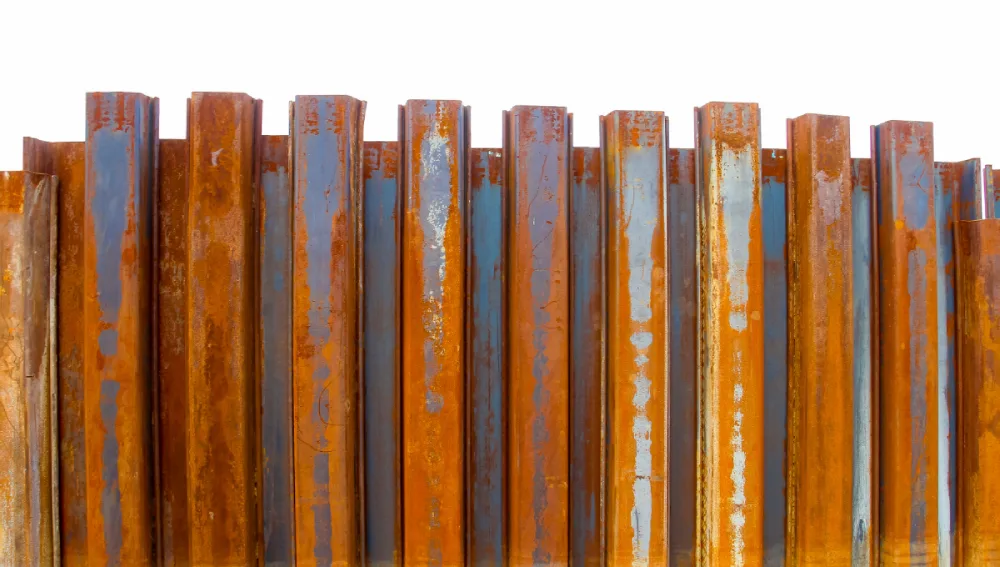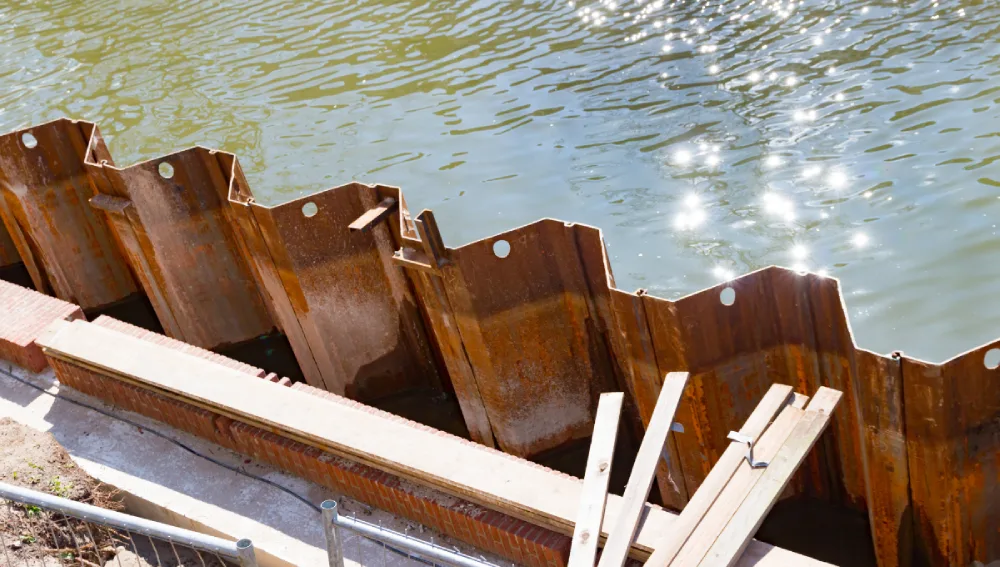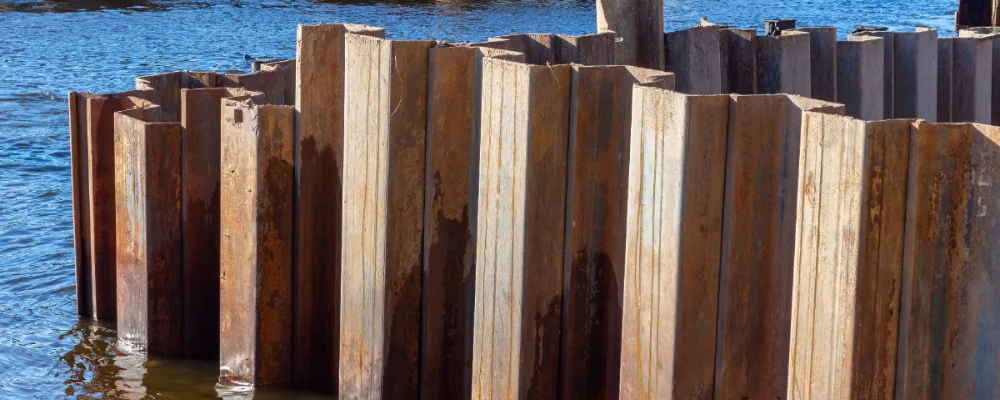Sheet pile walls are a type of structure used in construction and created to retain soil, or water, or both, most often available as an interlocking system such that individual pieces providing intermediate structural nature function together. Reading this article, you will learn about the term sheet piling, the concept, how it is used, the advantages and disadvantages of this technique, as well as about what the process entails.
What is a Sheet Pile?

A sheet pile is a thin, long sheet typically made of steel that interlocks with other sheets to form a continuous wall. Driven into the earth, these sheets create a barrier capable of retaining soil or water. Sheet piles are often employed in or near water bodies to hold back the surrounding soil.
What is Sheet Piling?
Sheet piling involves driving sheet piles into the soil, thereby creating a secure barrier. This technique is typically used in areas where the soil is unstable or where excessive water poses a threat to the site being excavated. These structures are called sheet pile walls.
How Does Sheet Piling Work?
Sheet piling involves driving interlocking sections into a appropriate materials, such as compacted sand (or other fill materials), to form an impermeable barrier. A machine drives these sheets into the ground, and the sheets are mechanically connected to create a durable and stable wall. Once in place, they can stop soil or water.
Types of Sheet Pile Foundations
There are various types of sheet pile foundations based on material type and installation method:
- Steel Sheet Piles: The most commonly used; created out of resilient and robust steel, making them ideal for handling large loads.
- Vinyl Sheet Piles: These are produced from plastic materials that are lighter in weight and do not corrode easily; hence, they are commonly used in marine environments.
- Wooden Sheet Piles: They are made from timber and utilized for temporary structures or areas where eco-friendliness is a priority.
- Concrete Sheet Piles: Made from concrete, these are very strong and durable, often used in permanent structures requiring long-term stability.
Benefits of Sheet Piling
- Versatility:
- Suitable for various soil types and conditions.
- Effective in both temporary and permanent applications.
- Can be used in urban and rural environments with equal efficiency.
- Strength:
- The interlocking design creates a strong, stable wall.
- Capable of withstanding significant pressure from soil and water.
- Provides excellent structural support for adjacent buildings and infrastructure.
- Speed:
- Installation is relatively quick, maintaining project schedules.
- Minimizes site disruption and downtime.
- Reduces labor costs due to faster completion times.
- Durability:
- Steel and vinyl sheet piles are long-lasting and resistant to corrosion.
- Capable of withstanding harsh environmental conditions.
- Require minimal maintenance over their lifespan.
- Reusability:
- Can often be removed and reused, making them cost-effective.
- Environmentally friendly due to the potential for recycling materials.
- Reduces waste and promotes sustainable construction practices.
Downsides of Sheet Piling
- Noise:
- Driving sheet piles can be very noisy, which can be problematic in residential areas.
- Noise pollution can disrupt local communities and lead to complaints.
- Mitigating noise requires additional measures, increasing project costs.
- Vibration:
- The process can cause vibrations affecting nearby structures.
- These vibrations can potentially damage sensitive buildings and infrastructure.
- Requires careful monitoring and possible mitigation techniques to prevent harm.
- Cost:
- Initial material and installation costs can be high.
- High upfront investment may not be feasible for all projects.
- Long-term maintenance can add to overall costs.
- Corrosion:
- Steel sheet piles can corrode over time, especially in marine environments.
- Corrosion can compromise the structural integrity of the piles.
- Mitigation with coatings and regular maintenance is necessary but adds to costs.
Sheet Piling Method

Sheet piling is one of the essential elements of many constructions that need to be built on the earth with unstable ground water . The following are the general methods used in sheet piling method:
Vibratory Hammer: This technique involves hitting the sheet piles with a vibratory hammer, which drives them into the ground. The hammer produces vibrations that decouple the soil, and thereby making it easier to penetrate through. It is most suitable for finer-grained soils and for sandy or gravely soils.
- Impact Hammer: In this method, an impact hammer is employed to hit the sheet piles with force, making them sink to the ground. It gently hammers at the top of the sheet pile, creating a transfer force to drive through the ground. It is suitable for operating in dense or hard soils when driving sheet piles.
- Press-in Method: This method is quite revolutionary in that hydraulic or mechanical presses are used to drive the sheet piles into the ground in portions. Another advantage of the press-in method is that, it is suitable for locations sensitive to noise and vibration.
- Pitch and Drive Method: During this method, the sheet piles are thrown into the ground and then driven to the needed depth with the help of an impact hammer. The method is very general and can be altered during the construction of the machine.
Practical Tips
- Proper Planning:
- Ensure the right type of sheet pile is chosen, and the installation method is appropriate.
- Conduct thorough site assessments to identify potential challenges and plan accordingly.
- Quality Material:
- Use high-quality materials for durability and stability.
- Source materials from reputable suppliers to guarantee their performance and longevity.
- Skilled Manpower:
- Hire experienced workers for proper installation.
- Provide ongoing training to workers to keep them updated on the latest techniques and safety protocols.
- Regular Inspections:
- Conduct inspections during construction to catch any issues early.
- Schedule post-installation inspections to ensure the integrity of the sheet pile wall over time.
- Environmental Considerations:
- Minimize the impact of noise and vibrations.
- Implement measures to protect local wildlife and habitats during construction activities.
FAQs
In construction projects with unstable soil or where water needs to be prevented from entering an excavation site, also for creating retaining walls.
They can be driven approximately twenty to thirty meters deep based on the specific project and soil conditions.
It is characterized by driving consecutive interconnecting sheets into the soil, which often creates a wall faster and more flexibly than any other method.
The time of installation may take several days up to weeks depending on the complexity and size of the project.
Yes, they can often be removed and reused in other projects, making them cost-effective.

